Danish words of the day: venstre/højre = left/right
The last birding tour was a failure in terms of birds, but I had high hopes for this one. Set in Gilleleje, on the north coast of Sjælland, our main targets were seabirds. In December, I had a great experience of seawatching in Gedser, and I was quite keen on a watch over the ocean. Furthermore, a young Iceland gull (Larus glaucoides) had elected to stay in the harbour this winter, and I hoped it would still be there.
Such promises encouraged me to wake up at 5, swallow a quick breakfast, and leave on an epic odyssey that would deliver me in the middle of nowhere, not far from the sea, after two and a half hour of transportation featuring three trains and two busses… err, what would I not do for birds? The shining sun lifted my mood, and I was dressed well enough to face the gusts of wind that threatened to turn us into ice. In the trees, Rooks (Corvus frugilegus) cackled. A new species to my portfolio!
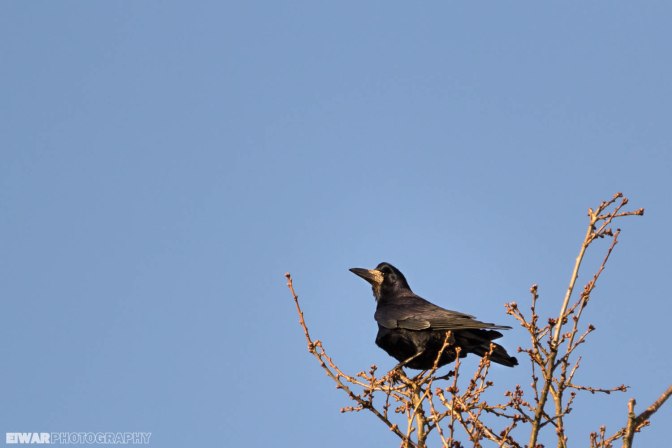
I met our tour leader Eric and a few other birders, and we settled for an hour of watch over the sea. We sat atop a cliff, so we had a good view on anything happening down there. Goldeneyes (Bucephala clangula), eiders (Somateria mollissima) and gulls formed the very core of our sightings, but a few Common scoters (Melanitta nigra) and Red-throated divers (Gavia stellata) could also be seen if one had luck and a sharp eye (and a good scope, also).
While it was easy to spot the birds, even the furthest ones, the tricky part came in when I wanted to give a view to someone else, especially when I needed some help for identification: the scope needed to be moved a bit ahead of the bird, so that it would appear when the next watcher had taken control of the scope. But how much was needed? If the bird was already gone, there was not much point in that. The scope being not so stable, I also had to make sure that the bird would still be approximately in the middle when I released it. Tricky, but not as tricky as indicating the position of a bird to someone else. “There, under the horizon but not too low, from the left, between the red ship and the blue one, coming soon to the red float with two flags, TOP, flying away, fast… did you see it?”. My main learning of the day? Of venstre and højre, now I know which one means left and which one means right 😉
As we were about to set sail to the harbour, I noticed two gull-like white spots under the horizon, very far away… Unconsciously, I think I knew there was something special about these birds, though I couldn’t figure out what it was. I put them in the scope, and Eric said “Sule!”, or gannet, in English. They are apparently a common sight up there, but what a pleasure! I realized soon after that their flight was actually quite different from the one of the other seabirds: ducks, for instance, fly in a line above the water, seemingly from point A to point B, with a purpose. The gannets flew at a much slower pace, playing with the wind, going up and down, left and right… I guess that’s what made me suspicious in the beginning. Stunning birds anyway.
As soon as we arrived to the harbour, I was on the lookout for the Iceland gull. I had seen pictures of it on Facebook, but I didn’t remember well. I simply searched a brownish bird (and there were plenty of those) with white wings. Both the French and Danish languages called this bird “White-winged gull”, which probably makes a bit more sense than Iceland gull, given that it doesn’t even breed in Iceland… but well. We looked at some groups of gulls, but no sign of it. In the distance, I spotted a flock of perch birds in flight, and Eric told me that they were Common redpolls (Acanthis flammea). “I need to see them”, that was my reaction. On the tour to Mosede Havn, I remember our guide Mikkel telling us that this tiny, overflying bird we had spotted was a Redpoll… but I had never seen these birds well, never observed their ablaze breast. Thus we decided that we would look for them later.

We turned around, walked some meters… and there it was! Lying on the ground in the middle of a larger group, the Iceland gull was taking a nap. I told you I didn’t really know what it would look like, but the white wings are absolutely ubiquitous, even when the bird is landed.

We observed it on its pier from accross a stretch of water, until some walkers disturbed it and its companions. Among birders, a lifer happens when you see a bird species for the first time in your life. You can also say a “tick” (une coche in French). That was the lifer of the day for me.
So, what about the other half-lifer? Well, you’ve probably already guessed it was the redpoll, right? After the gull take-off, we walked a bit north, to the outer dike. Eric said we should be wary of any passerine in the area, and seconds later, a flock of 10-20 redpolls landed in the grass next to us. What a sight to behold!
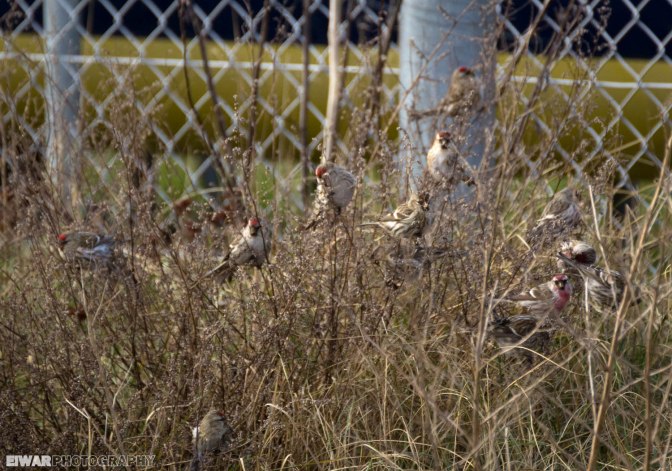
We were even treated with a few males showing off their gorgeous colors. I couldn’t work on pictures as well as I wished, and couldn’t find them again later, so this will have to do. I will try to return to the area.

After this show, we wandered a bit around the harbour, sighting various gulls and ducks. When we parted ways, I decided to stay in the harbour, for more pictures. After all, I had spent so much time in public transports, I had the right to prolong the fun, right? Eric told me that, if I was lucky, I could spot Purple sandpipers (Calidris maritima) on the rocks. Eager to make a second (and a half) tick that day, I climbed up the first rock and began a perilous trip along the dike. Spoiler alert: I didn’t see any sandpiper there. A male Common eider (Somateria mollissima) fled my progression, but I saw it come back later. I sat on a rock and witness its passage three meters from me.
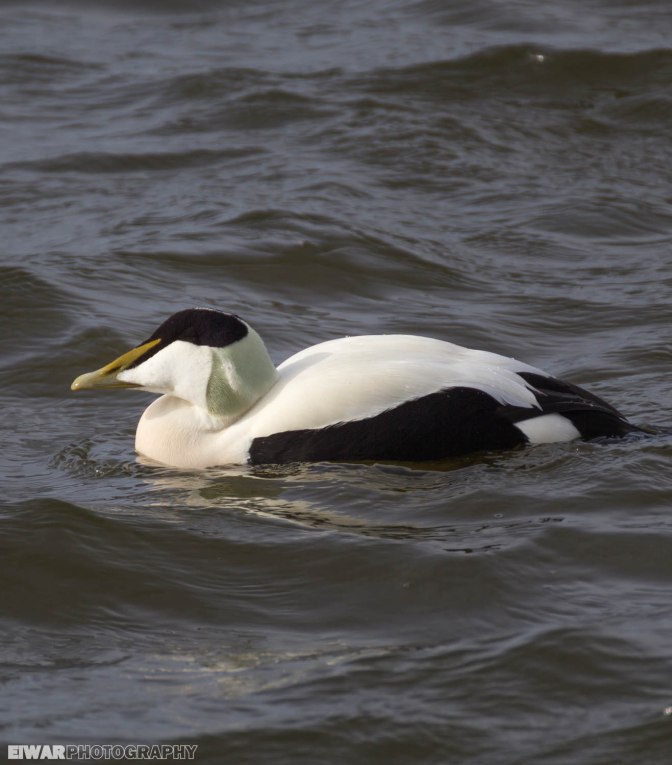
Unfortunately, my point of view was a bit too high (remember to shoot birds at eye level, whenever you can!), so I tried my luck on the beach. It was a bit farther than before, but I’m still happy with the results.

Later in the harbour, I spotted a female eider, and a Red-breasted merganser (Mergus serrator) which appeared surprisingly dark.



I found the Iceland gull again, it was resting with some friends on a pier again, close to the spot we had found it in the first place. I crawled behind a wooden wall not to be located by the birds, and peered in the openings, advancing bit by bit so that they get used to my presence.



Even with all these precautions, they flew away, and the last ones were the Iceland gull and a belligerent Herring gull (Larus argentatus).


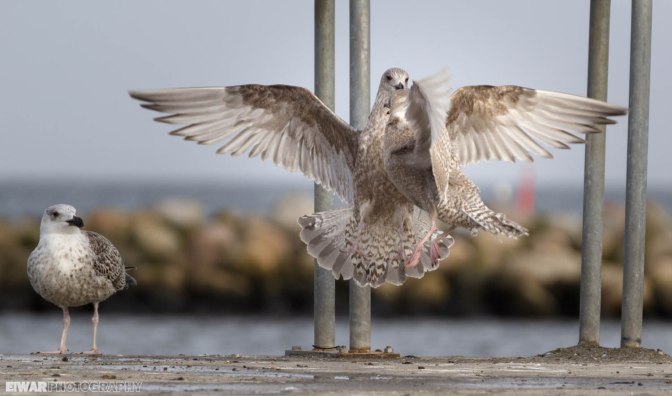


At some point, the vagrant regurgitated something, and brought it to a pool of water, where it abandoned it. Looks like feathers…


Anyway, I moved towards these last birds, trying to get closer shots. They looked at me, ever cautious, but didn’t move, until the Herring gull jumped on the Iceland one, making them both fly away. Appreciate the white wingtips!




Some more gulls in the harbour:
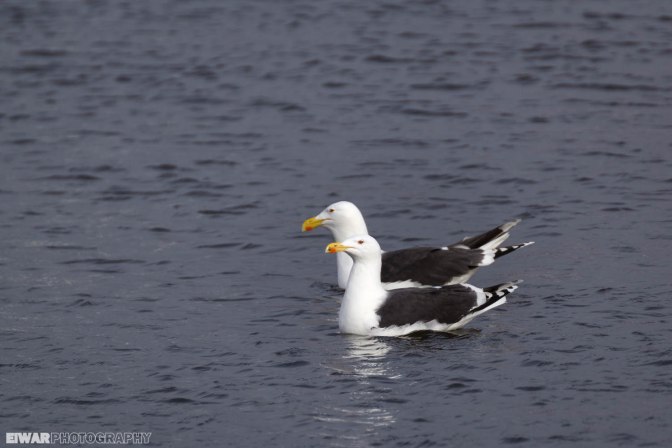


In the end, it took me another two hours to go back home (via Helsingør, making the day a loop as I had come via Hillerød), with 550 pictures to sort and develop… life is tough 😀
PS: it’s possible that I made some mistakes in identifying all these gulls. If you spot one, please tell me!










Une collection qui s’agrandit rapidement ! 🙂 Une belle moisson d’observations dans cet article.
LikeLiked by 1 person
Oh oui, c’était plutôt excitant 😀
LikeLiked by 1 person
Trop mignon le sizerin flammé, je ne connaissais pas cet oiseau ;).
LikeLiked by 1 person
Il est encore plus magnifique en vrai ❤
LikeLiked by 1 person
J’imagine! 🙂
LikeLiked by 1 person
Fantastiske billeder af toppet skallesluger 🙂
LikeLiked by 1 person
Tusind tak Hanna 🙂
LikeLiked by 1 person
No gull with blue wintips?
LikeLike